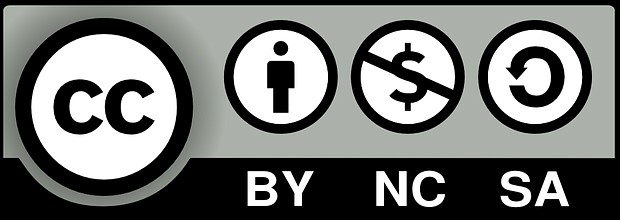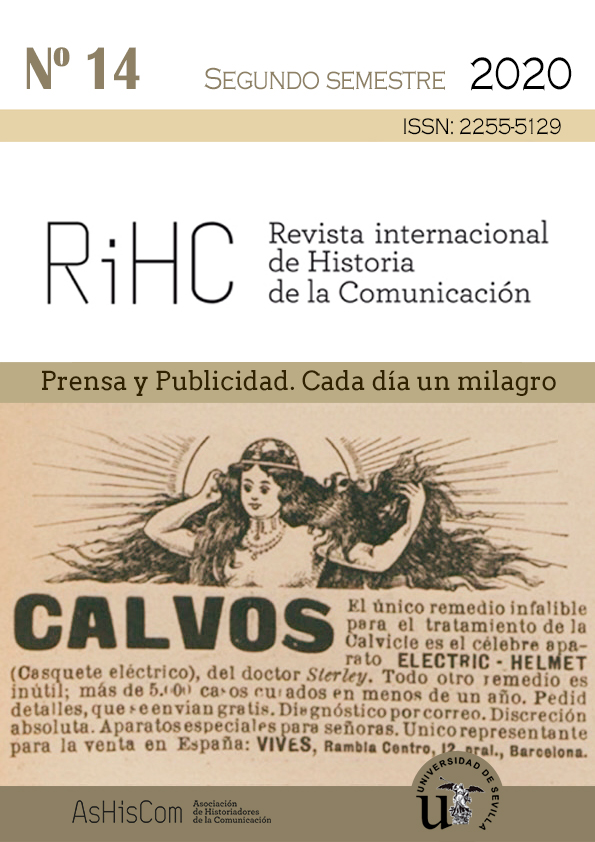Bayer: modernización y cosmopolitismo contra los salteadores de la salud
DOI:
https://doi.org/10.12795/RiHC.2020.i14.08Palabras clave:
Publicidad, productos milagro, Bayer, aspirina, modernidad, comportamiento del consumidorResumen
Según Adorno y Horkheimer, la publicidad es el elixir del capitalismo, es decir, el análisis del discurso y la industria publicitaria es fundamental para comprender la convergencia de fuerzas económicas, imaginarios sociales, identidades culturales y la cultura material que se deriva de ellas. En las primeras décadas del siglo XX, en el Diario de Costa Rica, Bayer es una de las marcas que destaca por publicitar productos acompañados de elaboradas ilustraciones y detalladas narraciones. Estas piezas publicitarias describen el sofisticado ethos moderno, caracterizado por un progreso cosmopolita que ofrece tanto nuevos placeres como nuevas preocupaciones y dolencias. Sin embargo, en piezas de similar formato a las anteriores, también se alerta a los consumidores sobre la preocupante circulación de preparaciones no autorizadas o falsificadas que atentan contra la salud de quienes, engañados, son víctima de los “salteadores de la salud”. Este artículo analiza un conjunto de piezas publicitarias de 1920 que dialogan y compiten con publicidad de otros medicamentos contemporáneos de diferente procedencia. La perspectiva metodológica combina los estudios visuales con el análisis crítico del discurso, mientras que la perspectiva teórica se basa en los estudios de cultura material, historia del consumo y teoría crítica.
Descargas
Citas
APPLEGATE, E. (1998): “Personalities and Products: A Historical Perspective On Advertising in America. Greenwood Press.
BERGMAN K. C. Y RING, J. (eds) (2014): “History of Allergy” en Chemical Immunology and Allergy, Vol 100, 2014.
BOTEY, A. M. (2017): “La tardía epidemia de la influenza o gripe española y sus desenlaces en Costa Rica (1918 – 1920)” en Americania. Revista de Estudios Latinoamericanos Nueva Epoca (Sevilla), n.6, jul – dic 2017, pp.8-52. Disponible en Internet ( 1-21-2020): https://dialnet.unirioja.es/ejemplar/478178
BRUNE, K. y BURKHARD, H. (2004): “The discovey and development of antyinflammatory drug” En Arthritis and Rheumatology Vol 50, No 8, 2004, pp 2391- 2399. Disponible en Internet (1-21-2020): https://onlinelibrary.wiley.com/doi/full/10.1002/art.20424
DE GRAZIA, V. (2005): Irresistible Empire: America’s Advantage through Twentieth Century Europe. Cambridge: Harvard University Press.
DYKSTRA, D. (1955). The Medical profession and patent and Proprietary Medicines During the Nineteenth Century. Bulletin of the History of Medicine Vol 29, No 5 Septiembre – Octubre, 1955 pp 401 – 419.
EDWARDS, J. (2011): “Yes, Bayer Promoted Heroin for Childern –Here Are The Ads that Prove It” enn Business Insider 17 de Noviembre. Disponible en Internet (1-21-2020): https://www.businessinsider.com/yes-bayer-promoted-heroin-for-children-here-are-the-ads-that-prove-it-2011-11
FOX, S. (1984). The Mirror Makers: A History of American Advertising and its Creators. New York: Morrow.
JACOME ROCA, A. (2003): Historia de los Medicamentos. Bogotá: Academia Nacional de Medicina.
JEFFREYS, D. (2004): The Remarkable Story of a Wonder Drug. Aspirin Story. London: Bloomsbury Publishing.
LOGO LIFE (2020): Disponible en Internet (1-1-20202): https://issuu.com/bis_publishers/docs/logolife/6
MCTAVISH, J (1999): “What Did Bayer Do before Aspirin? Early Pharmaceutical Marketing Prectices in America” En Pharmacy in History Vol 41, No. 1, pp 3-15. Disponible en Internet en (1-21-2020): https://www.jstor.org/stable/41111914?read-now=1&seq=9#page_scan_tab_contents
MACTAVISH, J. (1987): “Aspirin in Germany. The Pharmaceitical Industry and the Pharmaceutical Profession in Pharmacy in Industry” en Pharmacy in History Vol 29, No 3, pp 103 115. Disponible en Internet (1-1-2020): www.jstor.org/stable/41109885
MARCHAND, R (1985): Advertising. The American Dream. Berkeley: University of California Press.
SPICKA, M. E. (2007): Selling the Economic Miracle: Economic Reconstruction and Politics in West Germany, 1949 -1957. Oxford: Berghahn Books.
SPINKS, D. (2019): “Nostrum Remedium. A brief History of Pharmaceutical Marketing “. Disponible en Internet (1-21-2020): https://fluidic.agency/blog/nostrum-remedium-a-brief-history-of-pharmaceutical-marketing/
PITZ, H. C. (1969): “Charles Dan Gibson. Delineator of An Age” en Gillon, E. V. Jr (1969). The Gibson Girl and Her America. New York: Dove Publication
RAVIÑA ROVIRA, E. (2008): Medicamentos: Un viaje a lo largo de la evolución histórica del decubrimiento de fármacos. Vol 1. Galicia: Universidad de Santiago de Compostela.
VEGA JIMENEZ, P. (2007): “El Reinado de la Publicidad. Historia de la Publicidad en los Periódicos de Costa Rica” 1900- 19030” en En Patricia Vega (Comp.),
Encrucijadas de la comunicación (pp. 3-31). San José: Editorial Universidad de Costa Rica.
Descargas
Publicado
Cómo citar
Número
Sección
Licencia
RiHC. Revista internacional de Historia de la Comunicación es una publicación de acceso libre, ofrece su contenido bajo el principio de que hacer disponible gratuitamente la investigación al publico apoya a un mayor intercambio de conocimiento global.
RIHC. Revista internacional de Historia de la Comunicación se adhiere a las diferentes iniciativas que promueven el acceso libre al conocimiento, por lo que todos los contenidos son de acceso libre y gratuito y se publican bajo licencia de Creative Commons Reconocimiento-NoComercial 4.0 Internacional.

En virtud de ello, los autores que publiquen en esta revista aceptan las siguientes condiciones:
Los autores conservan los derechos de autor y ceden a la revista el derecho de la primera publicación, con el trabajo registrado con la licencia de atribución de Creative Commons, que permite a terceros utilizar lo publicado siempre que mencionen la autoría del trabajo y a la primera publicación en esta revista.
Los autores pueden realizar otros acuerdos contractuales independientes y adicionales para la distribución no exclusiva de la versión del artículo publicado en esta revista (p. ej., incluirlo en un repositorio institucional o publicarlo en un libro) siempre que indiquen claramente que el trabajo se publicó por primera vez en esta revista.
Se permite y recomienda a los autores publicar su trabajo en Internet (por ejemplo en páginas institucionales o personales) ya que puede conducir a intercambios productivos y a una mayor y más rápida difusión del trabajo publicado (vea The Effect of Open Access).
No prevé moving wall o período de embargo
Debe utilizarse la versión de editor/PDF
La fuente editorial debe reconocerse













